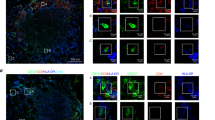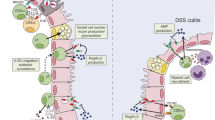Abstract
Ly49E is a member of the Ly49 family of NK receptors and is distinct from other members of this family on the basis of its structural properties, expression pattern and ligand recognition. Importantly, Ly49E receptor expression is high on small intestinal and colonic intraepithelial lymphocytes (IELs). Intestinal IELs are regulators of the mucosal immune system and contribute to front-line defense at the mucosal barrier, including anti-tumor immune response. Whereas most Ly49 receptors have MHC class-I ligands, we showed that Ly49E is instead triggered by urokinase plasminogen activator (uPA). uPA has been extensively implicated in tumor development, where increased uPA expression correlates with poor prognosis. As such, we investigated the role of Ly49E receptor expression on intestinal IELs in the anti-tumor immune response. For this purpose, we compared Ly49E wild-type mice to Ly49E knockout mice in two established tumor models: ApcMin/+-mediated and azoxymethane-induced intestinal cancer. Our results indicate that Ly49E expression on IELs does not influence the development or progression of intestinal cancer.




Similar content being viewed by others
Abbreviations
- AOM:
-
Azoxymethane
- DSS:
-
Dextran sodium sulfate
- IEL:
-
Intestinal intraepithelial lymphocyte
- KO:
-
Knockout
- uPA:
-
Urokinase plasminogen activator
- WT:
-
Wild-type
References
Bissahoyo A, Pearsall RS, Hanlon K, Amann V, Hicks D et al (2005) Azoxymethane is a genetic background-dependent colorectal tumor initiator and promoter in mice: effects of dose, route, and diet. Toxicol Sci 88:340–345
Haggar FA, Boushey RP (2009) Colorectal cancer epidemiology: incidence, mortality, survival, and risk factors. Clin Colon Rectal Surg 22:191–197
McClellan JL, Davis JM, Steiner JL, Day SD, Steck SE et al (2012) Intestinal inflammatory cytokine response in relation to tumorigenesis in the Apc(Min/+) mouse. Cytokine 57:113–119
Young PE, Womeldorph CM, Johnson EK, Maykel JA, Brucher B et al (2014) Early detection of colorectal cancer recurrence in patients undergoing surgery with curative intent: current status and challenges. J Cancer 5:262–271
Koido S, Ohkusa T, Homma S, Namiki Y, Takakura K et al (2013) Immunotherapy for colorectal cancer. World J Gastroenterol 19:8531–8542
Groh V, Steinle A, Bauer S, Spies T (1998) Recognition of stress-induced MHC molecules by intestinal epithelial gammadelta T cells. Science 279:1737–1740
Chen Y, Chou K, Fuchs E, Havran WL, Boismenu R (2002) Protection of the intestinal mucosa by intraepithelial gamma delta T cells. Proc Natl Acad Sci USA 99:14338–14343
Roberts AI, O’Connell SM, Biancone L, Brolin RE, Ebert EC (1993) Spontaneous cytotoxicity of intestinal intraepithelial lymphocytes: clues to the mechanism. Clin Exp Immunol 94:527–532
Ebert EC, Panja A, Praveen R (2009) Human intestinal intraepithelial lymphocytes and epithelial cells coinduce interleukin-8 production through the CD2–CD58 interaction. Am J Physiol Gastrointest Liver Physiol 296:G671–G677
Ebert EC, Groh V (2008) Dissection of spontaneous cytotoxicity by human intestinal intraepithelial lymphocytes: mIC on colon cancer triggers NKG2D-mediated lysis through Fas ligand. Immunology 124:33–41
Baker K, Foulkes WD, Jass JR (2009) MSI-H colorectal cancers preferentially retain and expand intraepithelial lymphocytes rather than peripherally derived CD8+ T cells. Cancer Immunol Immunother 58:135–144
Yokoyama WM, Plougastel BF (2003) Immune functions encoded by the natural killer gene complex. Nat Rev Immunol 3:304–316
Taveirne S, Filtjens J, Van Ammel E, De Colvenaer V, Kerre T et al (2011) Inhibitory receptors specific for MHC class I educate murine NK cells but not CD8alphaalpha intestinal intraepithelial T lymphocytes. Blood 118:339–347
Van Acker A, Filtjens J, Van Welden S, Taveirne S, Van Ammel E et al (2014) Ly49E expression on CD8alphaalpha-expressing intestinal intraepithelial lymphocytes plays no detectable role in the development and progression of experimentally induced inflammatory bowel diseases. PLoS One 9:e110015
Van Den Broeck T, Van Ammel E, Delforche M, Taveirne S, Kerre T et al (2013) Differential Ly49e expression pathways in resting versus TCR-activated intraepithelial gammadelta T cells. J Immunol 190:1982–1990
Van Den Broeck T, Stevenaert F, Taveirne S, Debacker V, Vangestel C et al (2008) Ly49E-dependent inhibition of natural killer cells by urokinase plasminogen activator. Blood 112:5046–5051
de Bruin PA, Griffioen G, Verspaget HW, Verheijen JH, Dooijewaard G et al (1988) Plasminogen activator profiles in neoplastic tissues of the human colon. Cancer Res 48:4520–4524
Duffy MJ (2005) Predictive markers in breast and other cancers: a review. Clin Chem 51:494–503
Protiva P, Sordat I, Chaubert P, Saraga E, Tran-Thang C et al (1998) Alterations in plasminogen activation correlate with epithelial cell dysplasia grading in colorectal adenomas. Br J Cancer 77:297–304
Sim PS, Stephens RW, Fayle DR, Doe WF (1988) Urokinase-type plasminogen activator in colorectal carcinomas and adenomatous polyps: quantitative expression of active and proenzyme. Int J Cancer 42:483–488
Sordat I, Chaubert P, Protiva P, Guillou L, Mazzucchelli L et al (1997) In situ stromal expression of the urokinase/plasmin system correlates with epithelial dysplasia in colorectal adenomas. Am J Pathol 150:283–295
Suzumiya J, Hasui Y, Kohga S, Sumiyoshi A, Hashida S et al (1988) Comparative study of plasminogen activator antigens in colonic carcinomas and adenomas. Int J Cancer 42:627–632
Ganesh S, Sier CF, Griffioen G, Vloedgraven HJ, de Boer A et al (1994) Prognostic relevance of plasminogen activators and their inhibitors in colorectal cancer. Cancer Res 54:4065–4071
Yang JL, Seetoo D, Wang Y, Ranson M, Berney CR et al (2000) Urokinase-type plasminogen activator and its receptor in colorectal cancer: independent prognostic factors of metastasis and cancer-specific survival and potential therapeutic targets. Int J Cancer 89:431–439
Dano K, Behrendt N, Hoyer-Hansen G, Johnsen M, Lund LR et al (2005) Plasminogen activation and cancer. Thromb Haemost 93:676–681
Killeen S, Hennessey A, El Hassan Y, Waldron B (2008) The urokinase plasminogen activator system in cancer: a putative therapeutic target? Drug News Perspect 21:107–116
Moser AR, Pitot HC, Dove WF (1990) A dominant mutation that predisposes to multiple intestinal neoplasia in the mouse. Science 247:322–324
Wang L, Zhang Q (2015) Application of the Apc(Min/+) mouse model for studying inflammation-associated intestinal tumor. Biomed Pharmacother 71:216–221
De Robertis M, Massi E, Poeta ML, Carotti S, Morini S et al (2011) The AOM/DSS murine model for the study of colon carcinogenesis: from pathways to diagnosis and therapy studies. J Carcinog 10:9
Neufert C, Becker C, Neurath MF (2007) An inducible mouse model of colon carcinogenesis for the analysis of sporadic and inflammation-driven tumor progression. Nat Protoc 2:1998–2004
Filtjens J, Taveirne S, Van Acker A, Van Ammel E, Vanhees M et al (2013) Abundant stage-dependent Ly49E expression by liver NK cells is not essential for their differentiation and function. J Leukoc Biol 93:699–711
Van Beneden K, De Creus A, Stevenaert F, Debacker V, Plum J et al (2002) Expression of inhibitory receptors Ly49E and CD94/NKG2 on fetal thymic and adult epidermal TCR V gamma 3 lymphocytes. J Immunol 168:3295–3302
Fraser KP, Gays F, Robinson JH, van Beneden K, Leclercq G et al (2002) NK cells developing in vitro from fetal mouse progenitors express at least one member of the Ly49 family that is acquired in a time-dependent and stochastic manner independently of CD94 and NKG2. Eur J Immunol 32:868–878
Hildenbrand R, Allgayer H, Marx A, Stroebel P (2010) Modulators of the urokinase-type plasminogen activation system for cancer. Expert Opin Investig Drugs 19:641–652
Puppa MJ, White JP, Sato S, Cairns M, Baynes JW et al (2011) Gut barrier dysfunction in the Apc(Min/+) mouse model of colon cancer cachexia. Biochim Biophys Acta 1812:1601–1606
McCart AE, Vickaryous NK, Silver A (2008) Apc mice: models, modifiers and mutants. Pathol Res Pract 204:479–490
Marsh L, Coletta PL, Hull MA, Selby PJ, Carding SR (2012) Altered intestinal epithelium-associated lymphocyte repertoires and function in ApcMin/+ mice. Int J Oncol 40:243–250
Ploplis VA, Tipton H, Menchen H, Castellino FJ (2007) A urokinase-type plasminogen activator deficiency diminishes the frequency of intestinal adenomas in ApcMin/+ mice. J Pathol 213:266–274
Dunn GP, Old LJ, Schreiber RD (2004) The three Es of cancer immunoediting. Annu Rev Immunol 22:329–360
Suzuki R, Kohno H, Sugie S, Tanaka T (2005) Dose-dependent promoting effect of dextran sodium sulfate on mouse colon carcinogenesis initiated with azoxymethane. Histol Histopathol 20:483–492
Matsuda S, Yamane T, Hamaji M (1998) CD4- and TCRalphabeta-positive T lymphocytes predominantly infiltrated into well-moderately differentiated colon adenocarcinoma tissues. Jpn J Clin Oncol 28:97–103
Herszenyi L, Barabas L, Hritz I, Istvan G, Tulassay Z (2014) Impact of proteolytic enzymes in colorectal cancer development and progression. World J Gastroenterol 20:13246–13257
de Bruin PA, Griffioen G, Verspaget HW, Verheijen JH, Lamers CB (1987) Plasminogen activators and tumor development in the human colon: activity levels in normal mucosa, adenomatous polyps, and adenocarcinomas. Cancer Res 47:4654–4657
Acknowledgments
We wish to thank Prof. Ria Cornelissen and Leen Pieters (Department of Basic Medical Sciences, Ghent University, Ghent, Belgium) for their aid in immunofluorescent staining of tumor sections.
Funding
This work was supported by grants from the Foundation against Cancer, a foundation of public interest (2014-214) (G. Leclercq), by the Research Fund—Belgium (FWO) (G.0187.13N) (G. Leclercq), by the Interuniversity Attraction Pole (IUAP) grant T-Time from the Belspo Agency (Project P7/39) (B. Vandekerckhove, T. Taghon, G. Leclercq), and by the BOF of Ghent University (BOF11/GOA/005) (J. Plum, G. Leclercq, B. Vandekerckhove, T. Taghon). A. Van Acker and J. Filtjens are supported by the Institute for the Promotion of Innovation through Science and Technology Flanders (IWT-Vlaanderen). S. Taveirne and T. Kerre are supported by the FWO. D. Elewaut is supported by the Research Fund—Flanders (FWO) and the Research Council of Ghent University. D. Elewaut is also a member of a multidisciplinary research platform (MRP) of Ghent University and is supported by Interuniversity Attraction Pole (IUAP) grant Devrepair from the Belspo Agency (Project P7/07). E. Louagie is supported by Interuniversity Attraction Pole (IUAP) grant Devrepair from the Belspo Agency (Project P7/07).
Author information
Authors and Affiliations
Corresponding author
Ethics declarations
Conflict of interest
The authors declare that they have no conflict of interest.
Electronic supplementary material
Below is the link to the electronic supplementary material.
Rights and permissions
About this article
Cite this article
Van Acker, A., Louagie, E., Filtjens, J. et al. The role of Ly49E receptor expression on murine intraepithelial lymphocytes in intestinal cancer development and progression. Cancer Immunol Immunother 65, 1365–1375 (2016). https://doi.org/10.1007/s00262-016-1894-6
Received:
Accepted:
Published:
Issue Date:
DOI: https://doi.org/10.1007/s00262-016-1894-6




